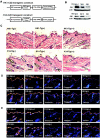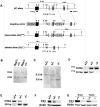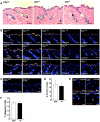The class II phosphoinositide 3-kinase C2beta is not essential for epidermal differentiation
- PMID: 16314532
- PMCID: PMC1316983
- DOI: 10.1128/MCB.25.24.11122-11130.2005
The class II phosphoinositide 3-kinase C2beta is not essential for epidermal differentiation
Abstract
Phosphoinositide 3-kinases (PI3Ks) regulate an array of cellular processes and are comprised of three classes. Class I PI3Ks include the well-studied agonist-sensitive p110 isoforms; however, the functions of class II and III PI3Ks are less well characterized. Of the three class II PI3Ks, C2alpha and C2beta are widely expressed in many tissues, including the epidermis, while C2gamma is confined to the liver. In contrast to the class I PI3K p110alpha, which is expressed throughout the epidermis, C2beta was found to be localized in suprabasal cells, suggesting a potential role for C2beta in epidermal differentiation. Overexpressing C2beta in epidermal cells in vitro induced differentiation markers. To study a role for C2beta in tissue, we generated transgenic mice overexpressing C2beta in both suprabasal and basal epidermal layers. These mice lacked epidermal abnormalities. Mice deficient in C2beta were then generated by targeted gene deletion. C2beta knockout mice were viable and fertile and displayed normal epidermal growth, differentiation, barrier function, and wound healing. To exclude compensation by C2alpha, RNA interference was then used to knock down both C2alpha and C2beta in epidermal cells simultaneously. Induction of differentiation markers was unaffected in the absence of C2alpha and C2beta. These findings indicate that class II PI3Ks are not essential for epidermal differentiation.
Figures







Similar articles
-
Class II PI3Ks α and β Are Required for Rho-Dependent Uterine Smooth Muscle Contraction and Parturition in Mice.Endocrinology. 2019 Jan 1;160(1):235-248. doi: 10.1210/en.2018-00756. Endocrinology. 2019. PMID: 30476019
-
The class II phosphoinositide 3-kinases PI3K-C2α and PI3K-C2β differentially regulate clathrin-dependent pinocytosis in human vascular endothelial cells.J Physiol Sci. 2019 Mar;69(2):263-280. doi: 10.1007/s12576-018-0644-2. Epub 2018 Oct 29. J Physiol Sci. 2019. PMID: 30374841 Free PMC article.
-
Novel roles for class II Phosphoinositide 3-Kinase C2β in signalling pathways involved in prostate cancer cell invasion.Sci Rep. 2016 Mar 17;6:23277. doi: 10.1038/srep23277. Sci Rep. 2016. PMID: 26983806 Free PMC article.
-
Class II PI3K Functions in Cell Biology and Disease.Trends Cell Biol. 2019 Apr;29(4):339-359. doi: 10.1016/j.tcb.2019.01.001. Epub 2019 Jan 25. Trends Cell Biol. 2019. PMID: 30691999 Review.
-
Class II PI3Ks at the Intersection between Signal Transduction and Membrane Trafficking.Biomolecules. 2019 Mar 15;9(3):104. doi: 10.3390/biom9030104. Biomolecules. 2019. PMID: 30884740 Free PMC article. Review.
Cited by
-
PI3K Isoform Signalling in Platelets.Curr Top Microbiol Immunol. 2022;436:255-285. doi: 10.1007/978-3-031-06566-8_11. Curr Top Microbiol Immunol. 2022. PMID: 36243848
-
The transient cortical zone in the adrenal gland: the mystery of the adrenal X-zone.J Endocrinol. 2019 Apr;241(1):R51-R63. doi: 10.1530/JOE-18-0632. J Endocrinol. 2019. PMID: 30817316 Free PMC article. Review.
-
Inactivation of class II PI3K-C2α induces leptin resistance, age-dependent insulin resistance and obesity in male mice.Diabetologia. 2016 Jul;59(7):1503-1512. doi: 10.1007/s00125-016-3963-y. Epub 2016 Apr 30. Diabetologia. 2016. PMID: 27138914 Free PMC article.
-
PIK3C2B inhibition improves function and prolongs survival in myotubular myopathy animal models.J Clin Invest. 2016 Sep 1;126(9):3613-25. doi: 10.1172/JCI86841. Epub 2016 Aug 22. J Clin Invest. 2016. PMID: 27548528 Free PMC article.
-
Phosphatidylinositol 3-kinase class II α-isoform PI3K-C2α is required for transforming growth factor β-induced Smad signaling in endothelial cells.J Biol Chem. 2015 Mar 6;290(10):6086-105. doi: 10.1074/jbc.M114.601484. Epub 2015 Jan 22. J Biol Chem. 2015. PMID: 25614622 Free PMC article.
References
-
- Anderson, K. E., and S. P. Jackson. 2003. Class I phosphoinositide 3-kinases. Int. J. Biochem. Cell Biol. 35:1028-1033. - PubMed
-
- Arcaro, A., S. Volinia, M. J. Zvelebil, R. Stein, S. J. Watton, M. J. Layton, I. Gout, K. Ahmadi, J. Downward, and M. D. Waterfield. 1998. Human phosphoinositide 3-kinase C2β, the role of calcium and the C2 domain in enzyme activity. J. Biol. Chem. 273:33082-33090. - PubMed
-
- Bedogni, B., M. S. O'Neill, S. M. Welford, D. M. Bouley, A. J. Giaccia, N. C. Denko, and M. B. Powell. 2004. Topical treatment with inhibitors of the phosphatidylinositol 3′-kinase/Akt and Raf/mitogen-activated protein kinase kinase/extracellular signal-regulated kinase pathways reduces melanoma development in severe combined immunodeficient mice. Cancer Res. 64:2552-2560. - PubMed
Publication types
MeSH terms
Substances
Grants and funding
LinkOut - more resources
Full Text Sources
Molecular Biology Databases
Research Materials
